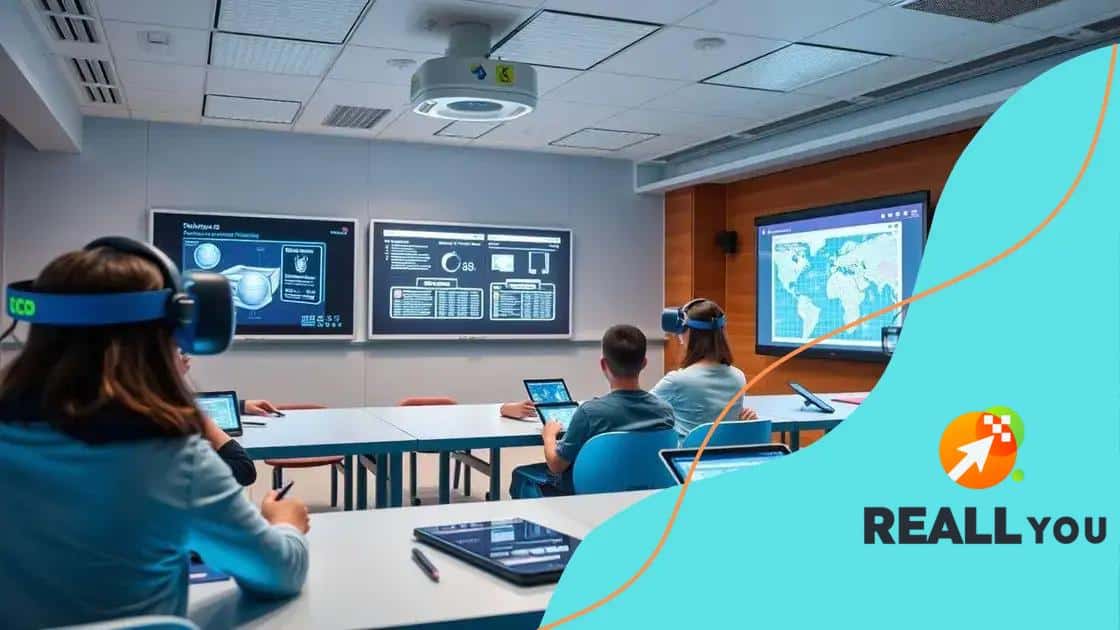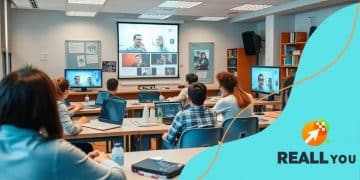How virtual learning is transforming higher education globally

Anúncios
Virtual learning is transforming higher education globally by increasing accessibility, offering flexible scheduling, and utilizing innovative technologies to enhance student engagement and personalize educational experiences.
How virtual learning is transforming higher education globally isn’t just a trend; it’s a significant shift reshaping education as we know it. Imagine studying from the comfort of your home while gaining valuable insights from experts around the world. Let’s delve into this transformation.
Anúncios
The rise of virtual classrooms
The rise of virtual classrooms has dramatically changed how education is delivered and received. Many students now have the opportunity to connect with their teachers and peers without being restricted by geographical boundaries. This shift has made education more accessible and adaptable to various needs.
Anúncios
Benefits of virtual classrooms
One of the most significant advantages is flexibility. Students can learn at their own pace, which is essential for those who need more time to grasp concepts. Furthermore, the virtual setting often offers a wider range of courses and resources than traditional classrooms.
- Access to diverse learning materials
- Interaction with a global network of educators
- Customized learning experiences
- Convenient scheduling options
Another important aspect of virtual classrooms is the technology involved. Platforms like Zoom, Google Classroom, and others have made it easier for teachers to present lessons and for students to engage actively. This technology enables real-time feedback and collaboration between peers, enriching the learning experience.
Challenges faced
Despite the many benefits, there are challenges that come with this new mode of education. A significant concern is the lack of social interaction, which can lead to feelings of isolation among students. Additionally, not all students have equal access to reliable internet and devices, which can create disparities in learning opportunities.
As we move forward, it’s important to address these challenges carefully. Solutions such as improving internet infrastructure and offering more support for technology training can help bridge these gaps. The rise of virtual classrooms offers a unique opportunity to reshape education for a post-pandemic world.
Benefits of online learning for students

Online learning offers numerous advantages for students that can enhance their educational experiences. One significant benefit is the flexibility it provides. Students can access lessons and resources at their convenience, which accommodates different learning styles and schedules. This means they can study when they feel most alert and focused.
Personalized Learning Experience
Another important aspect of online learning is the ability to tailor education to individual needs. Platforms can adapt content based on a student’s progress and preferences, allowing them to move at their own pace. This personalization helps keep students engaged and motivated.
- Interactive learning formats, such as quizzes and videos
- Access to a wide range of resources and materials
- Ability to revisit difficult concepts easily
- Less pressure from peer comparison during learning
The accessibility of online learning is also crucial. Students from remote areas or those with physical disabilities can participate in classes without the challenges of commuting or physical attendance. This opens up education to a broader audience, ensuring that more students can pursue their academic goals.
Cost Savings
Additionally, online learning can lead to cost savings for students. Without the need for commuting and associated expenses like gas or public transport, students can save money. Moreover, many online courses are often less expensive than traditional classroom settings, which can ease financial burdens.
As we see these benefits of online learning unfold, it’s clear that this mode of education is reshaping opportunities for students everywhere. The combination of flexibility, cost savings, and accessibility makes online learning a vital part of modern education.
Challenges faced by higher education institutions
Higher education institutions are facing unique challenges in the era of virtual learning. As they adapt to this new landscape, they must confront various issues that test their resilience and adaptability.
Technology Integration
One major challenge is the integration of technology into the curriculum. Many institutions may struggle with outdated systems or lack the necessary resources to implement new tools effectively. This can impede the learning experience for both students and faculty.
- Need for reliable infrastructure
- Training staff on new technology
- Maintaining cybersecurity measures
- Ensuring equity in technology access
Another significant hurdle is ensuring student engagement and participation. In a virtual setting, students may feel less inclined to participate actively in discussions or activities. This disengagement can lead to lower retention rates and academic performance.
Financial Constraints
Many higher education institutions are also facing financial challenges. With declining enrollment and limited funding, maintaining quality education becomes increasingly difficult. This pressure can result in budget cuts, which may affect course offerings, faculty positions, and student services.
Furthermore, institutions need to find ways to attract and retain students while providing value. Competing with online programs and establishing a strong digital presence are essential for survival in this competitive environment.
As the landscape shifts, it’s crucial for higher education institutions to continuously adapt and innovate. Understanding these challenges will help them strategize for a successful future amid ongoing changes in the education sector.
The future of education technology

The future of education technology promises to reshape how students learn and interact with educational content. Emerging technologies are continuously advancing, creating opportunities for more engaging and effective learning experiences.
Innovative Learning Tools
One aspect of the future is the rise of innovative learning tools. Virtual and augmented reality (VR and AR) will provide students with immersive experiences that enhance understanding of complex subjects. Imagine exploring historical events or scientific environments right from the classroom.
- Enhanced engagement through interactive simulations
- Real-life applications of theoretical concepts
- Access to global resources and experts
- Collaborative learning environments
Another trend is the increasing use of artificial intelligence (AI) in education. AI can personalize learning experiences by adapting content to meet individual student needs. This approach allows students to work at their own pace and receive tailored support, making education more effective.
Data-Driven Insights
The use of big data will also play a crucial role in shaping education. By analyzing performance data, educational institutions can identify trends, strengths, and areas for improvement. This insight will help schools create better programs, enhance curriculum, and support students more effectively.
As education technology continues to evolve, it is essential for institutions to remain flexible and open to new methods. This adaptability will ensure that students are equipped with the skills they need for a rapidly changing world. Collaboration between educators, technology providers, and students will be vital to harnessing the full potential of these advancements.
Real-world examples of virtual learning success
Real-world examples of virtual learning success illustrate how online education is transforming student experiences and outcomes. Institutions around the globe are harnessing the power of technology to deliver effective learning solutions.
Case Study: The University of Phoenix
The University of Phoenix has successfully utilized online platforms to reach a diverse student body. By offering a wide array of degree programs online, this university allows students to balance education with personal and professional commitments. Their flexible schedules and interactive learning environments have helped many adult learners achieve their academic goals.
- Variety of courses available anytime
- Support for working students
- Collaborative online tools for group projects
- High graduation rates among online learners
Another example is the use of virtual learning during the COVID-19 pandemic. Schools and universities rapidly transitioned to online formats, demonstrating adaptability and resilience. Educators integrated platforms like Zoom and Microsoft Teams, allowing lessons to continue seamlessly while keeping students engaged.
Innovative Practices
Many institutions embraced innovative practices that enhanced the online learning experience. For instance, flipped classrooms enabled students to learn at their own pace before engaging in discussions during live sessions. Such strategies have proven effective in maintaining students’ interest and improving retention of information.
As we explore these real-world examples, it is clear that virtual learning can provide valuable educational experiences. By incorporating technology thoughtfully and actively engaging students, institutions can create successful learning environments despite geographical or physical limitations.
FAQ – Frequently Asked Questions about Virtual Learning in Higher Education
What are the main benefits of virtual learning?
The main benefits include flexibility in scheduling, accessibility for students worldwide, and personalized learning experiences tailored to individual needs.
How can technology enhance virtual learning?
Technology can enhance virtual learning through tools like virtual reality for immersive experiences and artificial intelligence for tailored educational support.
What challenges do higher education institutions face with online education?
Institutions face challenges like integrating new technology, ensuring student engagement, and financial constraints due to changing enrollment patterns.
Are there successful examples of virtual learning?
Yes, examples include the University of Phoenix and the rapid transition of many schools during the COVID-19 pandemic to online formats, which showed adaptability and innovation.






